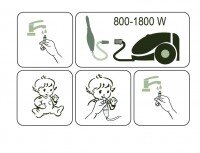
A runny nose - The importance of removing the stagnant nasal secretion
A running nose for babies and toddlers is very common. Toddlers suffer from running cold six times a year on average.

Place the child or infant in a sitting / upright position. We recommend to hold the child in your lap until he/she feels comfortable with this apparatus.
Position the evacuator (A) so that it should fully seal one of the nostrils and hold it there for a couple of seconds while observing the discharge being deposited in the collecting cylinder. (B)
You may gently rotate the evacuator in a circular motion.
Repeat this process in the same or/and the other nostril daily or as needed.
Sterilization:
Clean the units before and after each use by washing it with hot soapy water. Rinse with hot or warm water. Do not use any detergents, chemicals or abrasive materials on it.
Assembly:
Disassembly:
Remove the vacuum cleaner adapter (C) from the operating vacuum, and then turn it off.
Two evacuators can be found in the box.



A running nose for babies and toddlers is very common. Toddlers suffer from running cold six times a year on average.

Paranasal sinuses open to upper part of the common nasal canals. Owing to anatomical reasons he secretion produced here may flow backwards more easily than towards the nostrils on the face.
Our website uses cookies so that we can create statistics about the steps you take on our website. If you continue to use our website, you consent to the use of cookies. With this activity, we cannot identify you personally.